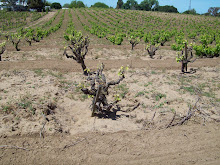.jpg)
Kathy here. In my online research I spend a lot of time looking for variations of “contra costa county wines” and “Oakley grapes.” I managed to find a message board that was cataloging old vineyards. In the course of the discussion someone mentioned how Toucan Wines’ newsletter announced their latest Evangelho Vineyard release. What? Another wine to search out and find. Of course, I immediately looked up their Web site and saw that all of the Evangelho Carignane was sold out. Oh well, I’d sign up for their newsletter.
Approximately a month later an announcement came through the e-mail — the Carignane had been released. I immediately got on the phone to owner Doug Timewell.
Doug met Frank Evangelho down near his ‘hood of Arroya Grande. Frank was helping a neighbor plan out a vineyard and got to know Doug’s wines. Later when a contract for the Carignane fell through, Frank offered the grapes to Doug.
Doug originally made Carignane from Frank’s grapes in 2006. Those bottles sold out immediately. He and co-owner Terrie Leivers have just 200 cases of the 2008 (Frank didn’t have enough grapes in 2009 as it was a tough year).
I asked Doug about the eminent domain seizure of Frank’s property. He said that Frank was able to harvest his grapes in the year in question (hooray), but the whole thing was so hard on Frank that no one asks him about it. Frank, here’s to you. Your grapes make some tasty juice.
Doug’s Carignane has an amazingly high alcohol content of 15.9%, but you would never know it. It has a nose of blueberry pie with a bit of clove and cinnamon. There is a nice acidity to balance out the fruit and the wine has beautiful long finish. Tony picked up a bit of pumpkin pie spice (nutmeg, clove and cinnamon) and got a bit of pie crust in the mouthfeel. My biggest note was mmmmmmm.



